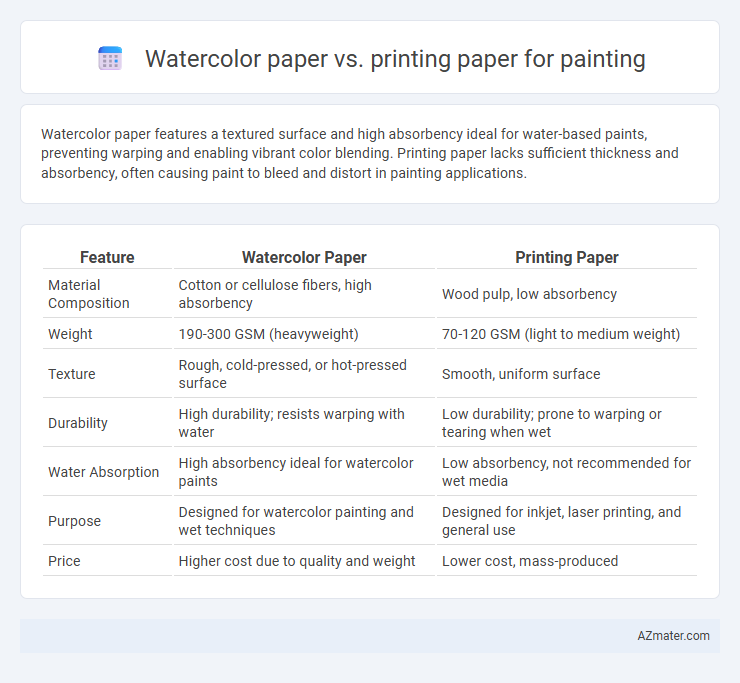Watercolor paper features a textured surface and high absorbency ideal for water-based paints, preventing warping and enabling vibrant color blending. Printing paper lacks sufficient thickness and absorbency, often causing paint to bleed and distort in painting applications.
Table of Comparison
| Feature | Watercolor Paper | Printing Paper |
|---|---|---|
| Material Composition | Cotton or cellulose fibers, high absorbency | Wood pulp, low absorbency |
| Weight | 190-300 GSM (heavyweight) | 70-120 GSM (light to medium weight) |
| Texture | Rough, cold-pressed, or hot-pressed surface | Smooth, uniform surface |
| Durability | High durability; resists warping with water | Low durability; prone to warping or tearing when wet |
| Water Absorption | High absorbency ideal for watercolor paints | Low absorbency, not recommended for wet media |
| Purpose | Designed for watercolor painting and wet techniques | Designed for inkjet, laser printing, and general use |
| Price | Higher cost due to quality and weight | Lower cost, mass-produced |
Understanding Watercolor Paper: Key Features
Watercolor paper features a textured surface designed to absorb water and pigment effectively, preventing warping and allowing vibrant color blending. It is typically made from 100% cotton or cellulose fibers, offering superior durability and archival quality compared to printing paper. Unlike printing paper, watercolor paper's weight ranges commonly from 140 to 300 gsm, providing the strength necessary to withstand repeated washes and intense painting techniques.
What Defines Printing Paper?
Printing paper is typically defined by its smooth surface, lightweight composition, and lower absorbency compared to watercolor paper, making it ideal for ink and laser prints. This type of paper usually consists of wood pulp with less texture and minimal sizing, which prevents ink from bleeding but limits its ability to hold wet media like paint. Its fine, even finish emphasizes sharp image reproduction rather than soaking up paint, distinguishing it clearly from the textured, thicker, and more absorbent qualities of watercolor paper.
Surface Texture: Roughness and Smoothness Compared
Watercolor paper features a textured surface with varying degrees of roughness, designed to hold water and pigment effectively, enhancing paint absorption and color depth. Printing paper, typically smooth and thin, lacks the textured fibers necessary for watercolor techniques, causing paint to pool or smear rather than evenly disperse. The roughness of watercolor paper creates natural resistance to brush strokes, allowing for greater control and varied artistic effects compared to the slick surface of smooth printing paper.
Weight and Thickness: Durability for Painting
Watercolor paper typically ranges from 190gsm to 300gsm or more, offering greater thickness and durability crucial for handling wet media without warping or buckling. Printing paper usually measures around 75gsm to 120gsm and lacks the structural integrity, often causing tears or curling during watercolor application. Thicker watercolor paper ensures better absorption and longevity, making it ideal for artists seeking a reliable surface for painting.
Absorption: How Paper Handles Water and Pigment
Watercolor paper's high absorption capacity allows it to hold water and pigment effectively, preventing buckling and enabling smooth color blending and layering. Printing paper, designed primarily for ink, lacks this absorbency, causing water and paints to pool or bleed, which results in uneven textures and less vibrant watercolor effects. The fiber composition and weight of watercolor paper enhance its durability under wet conditions, making it the preferred choice for artists working with water-based media.
Archival Quality: Longevity of Artwork
Watercolor paper offers superior archival quality due to its acid-free, cotton or cellulose fiber composition, preventing yellowing and degradation over time. Printing paper, often made from wood pulp with higher acidity, tends to deteriorate faster, compromising the longevity of artwork. Artists seeking long-lasting pieces should prioritize 100% cotton, cold-pressed watercolor paper for optimal preservation.
Color Vibrancy and Paint Lifting
Watercolor paper features a textured surface designed to absorb pigment and water evenly, enhancing color vibrancy and preventing paint lifting during rewetting or corrections. Printing paper, being smooth and less absorbent, often causes colors to appear dull and may lead to paint lifting or smudging when watercolors are applied. The higher cotton content and weight of watercolor paper also contribute to better pigment retention and controlled blending, making it superior for dynamic watercolor techniques.
Cost Differences: Analyzing Affordability
Watercolor paper typically costs more than printing paper due to its specialized texture and higher weight designed to absorb water without warping. Printing paper is generally more affordable but lacks the durability and water resistance required for watercolor painting, which can lead to poor results and the need for additional supplies. Choosing between them depends on balancing budget with the quality and longevity of the artwork, with watercolor paper being a worthwhile investment for professional-grade projects.
Availability and Range of Sizes
Watercolor paper is widely available in specialty art stores and online, offering a broad range of sizes from small sheets suitable for practice to large formats designed for professional artworks. Printing paper, commonly found in office supply stores, primarily comes in standard sizes such as A4 and Letter, limiting options for artists who need varied dimensions. The extensive size variety in watercolor paper supports diverse painting techniques, making it more adaptable than printing paper for artistic use.
Choosing the Right Paper for Your Painting Style
Watercolor paper features a textured surface and higher absorbency designed to handle wet media without warping, making it ideal for watercolor and gouache painting styles. Printing paper, typically thinner and smoother, tends to absorb less moisture and may cause colors to bleed or buckle when used with water-based paints. Selecting the right paper depends on the painting technique: choose heavyweight, cold-pressed watercolor paper for fluid, layered washes, while printing paper suits dry media or light ink work.

Infographic: Watercolor paper vs Printing paper for Painting
 azmater.com
azmater.com